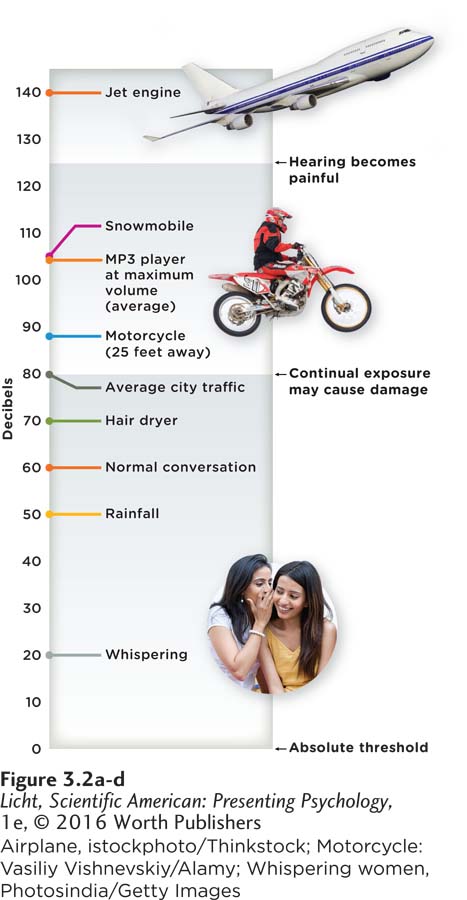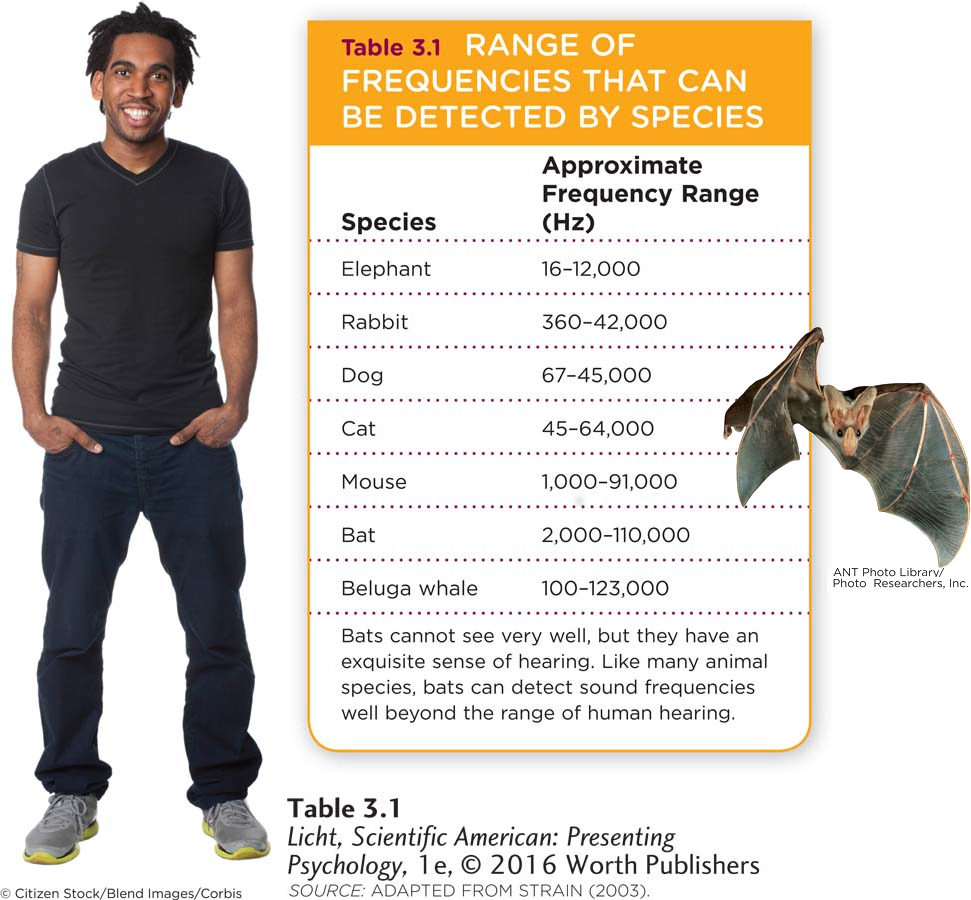3.3 Hearing

Liz sits with her firstborn Sarah (left back), and the triplets (left to right) Sophie, Emma, and Zoe. The triplets were about 12 months when this photo was taken.
 THE EARS OF THE TRIPLETS Taking care of three blind infants and a preschooler was no easy task, but Liz was strong, stubborn, and determined to see her girls thrive. They were beginning to reach the major developmental milestones of babyhood—
THE EARS OF THE TRIPLETS Taking care of three blind infants and a preschooler was no easy task, but Liz was strong, stubborn, and determined to see her girls thrive. They were beginning to reach the major developmental milestones of babyhood—
It started with Zoe, who out of the blue stopped playing with her favorite toy, the cube that made different sounds when she pushed on its sides. Zoe would push the buttons over and over, then burst into tears. Eventually, Zoe and her sisters stopped responding to Liz’s voice. It was also during this period that the triplets began to act as if they had some kind of stomach illness—
Both conditions—
Listen, Hear
LO 7 Summarize how sound waves are transduced into the sensation of hearing.
audition The sense of hearing.
The wind howling. A baby crying. Raindrops pelting the roof of a car. These sounds are perceived so differently, yet they all begin with the same type of stimulus: a sound wave moving through the environment. When we use our sense of hearing, or audition, we are detecting sound waves that enter our ears. Sound waves are rhythmic vibrations of molecules traveling through air or other materials, like water, metal, or wood.
SOUND WAVES Every sound wave begins with a vibration. That could mean a pulsating loudspeaker, a quivering guitar string, or vocal chords fluttering in your throat. When an object vibrates, it sends a pressure disturbance through the molecules of the surrounding medium (usually air). Imagine a very quiet environment, such as the inside of a parked car, where the air molecules are evenly distributed for the most part. Now turn on the radio, and the membrane of the amplified speaker immediately bulges outward, pushing air molecules out of its way. This creates a zone where the particles are tightly packed and the pressure is high; the particles directly in front of the speaker will hit the particles right in front of them, and so on throughout the interior of your car. As the speaker retracts, or pulls back, it gives the air particles ample room to move, creating a zone where particles are spread out and pressure is low. As the speaker rhythmically pushes back and forth, it sends cycles of high pressure waves (with particles “bunched up”) and low pressure waves (with particles “spread out”) rippling through the air (Ludel, 1978). It’s important to note that molecules are not being transmitted when you speak to a friend across the room; air particles from your mouth do not travel to his ears, only the sound wave does.
Synonyms
loudness volume
Now that we have established what sound waves are—
LOUDNESS Let’s begin by exploring loudness. We sense the loudness of a sound based on the amplitude, or height, of the wave it generates. A kitten purring generates low-

Loudness is measured in decibels (dB). The absolute threshold for human hearing—
pitch The degree to which a sound is high or low determined by the frequency of its sound wave.
frequency The number of sound waves passing a given point per second; higher frequency is perceived as higher pitch, and lower frequency is perceived as lower pitch.

PITCH The pitch of a sound describes how high or low it is. An example of a high-
When Emma, Zoe, and Sophie began to go deaf, they lost their ability to hear high frequencies first, which means they stopped hearing high-
TIMBRE We know that sounds can have different levels of loudness and pitch, but how is it possible that two sounds with similar loudness and pitch (Beyoncé and Ariana Grande belting the same note at the same volume) can sound so different? The answer to this question lies in their timbre. The texture of a sound, or timbre (ʹtam-
All Ears
We have outlined the basic properties of sound. Now let’s learn how the ears transform sound waves into the language of the brain. As you will see, your ears are extraordinarily efficient at what they do—
FROM SOUND WAVE TO BONE MOVEMENTS What exactly happens when a sound wave reaches your ear? First it is ushered inside by the ear’s funnel-
INFOGRAPHIC 3.3

cochlea (kō-klē-ə) Fluid-
FROM BONE MOVEMENT TO MOVING FLUID The primary component of the inner ear is the cochlea (kō-klē-ə), a snail-
COCHLEAR IMPLANTS The cochlea is an extremely delicate structure. If the hair cells are damaged or destroyed, they will not regrow like blades of grass (at least in humans and other mammals). So when Emma, Zoe, and Sophie lost their hearing around age 2, there was no magical drug or surgical procedure that could restore their hearing. Hope arrived about a year later, when the triplets were outfitted with cochlear implants, electronic devices that help those who are deaf or hard-
Cochlear implants have enabled many people to understand language and appreciate music, but “hearing” with a cochlear implant is not exactly the same as hearing with two ears. Voices may sound computerized or Mickey Mouse-
CONTROVERSIES
Conflicted Feelings About Cochlear Implants
 Cochlear implants are a marvel of modern technology. To take a brain full of silence and fill it with sound—
Cochlear implants are a marvel of modern technology. To take a brain full of silence and fill it with sound—
SOME DEAF INDIVIDUALS VIEW THEIR DEAFNESS AS A GIFT. . . .
You might be wondering why the triplets were provided with cochlear implants, not hearing aids. Hearing aids work by increasing the amplitude of incoming sound waves (making them louder) so the hair cells in the inner ear can better detect them. If hair cells are damaged beyond repair, as was the case for Emma, Zoe, and Sophie, then the inner ear cannot pass along messages to the brain. There will be no sensation of hearing, no matter how much you turn up the volume.
How the Brain Perceives Pitch
We know how sound waves are transformed into auditory sensations, but there are many types of sounds. How does the brain know the difference between the yap of a Chihuahua and the deep bark of a Rottweiler, the sweet song of a flute and the bellow of a tuba? In other words, how do we distinguish between sound waves of high and low frequencies? There are two complementary theories that explain how the brain processes pitch.
LO 8 Illustrate how we sense different pitches of sound.
place theory States that pitch corresponds to the location of the vibrating hair cells along the cochlea.
PLACE THEORY According to place theory, the location of neural activity along the cochlea allows us to sense the different pitches of high-
Place theory works well for explaining higher-
frequency theory States that pitch is determined by the vibrating frequency of the sound wave, basilar membrane, and associated neural impulses.
FREQUENCY THEORY To understand how humans perceive lower pitches, we can use the frequency theory, which suggests it is not where along the cochlea hair cells are vibrating, but how frequently they are firing (the number of neural impulses per second). The entire basilar membrane vibrates at the same frequency as a sound wave, causing the hair cells to be activated at that frequency, too. The nearby neurons fire at the same rate as the vibrations, sending signals through the auditory nerve at this rate. If the sound wave has a frequency of 200 Hz, then the basilar membrane vibrates at 200 Hz, and the neurons in the auditory nerve fire at this rate as well.
CONNECTIONS
In Chapter 2, we described how neurons must recover after they fire, so that each neuron can return to its resting potential. It is during this period that they cannot fire, that is, they are “recovering.”
volley principle States that the perception of pitches between 400 and 4,000 Hz is made possible by neurons working together to fire in volleys.
Neurons, however, can only fire so fast, the maximum rate being about 1,000 times per second. How does the frequency theory explain how we hear sounds higher than 1,000 Hz? According to the volley principle, neurons can “work” together so that their combined firing can exceed 1,000 times per second. Imagine a hockey team practicing for a tournament. The coach challenges the players to fire shots on goal at a faster rate than one individual. The team members get together and decide to work in small groups and alternate shots on the goal. The first group skates and shoots, and as they are skating away from the goal to return to the back of the line, the next group takes their shots. Each time a group is finished shooting, the next group is ready to shoot. Neurons grouped together in the same way will fire in volleys; as one group of neurons finishes firing and is “recovering,” the next group will fire. The frequency of the combined firing of all groups results in one’s perception of the pitch of the sound.
ALL TOGETHER NOW Let’s draw this all together. Human beings can hear sounds ranging in frequency from 20 to 20,000 Hz. The frequency theory explains how we perceive sounds from 20 to 400 Hz; the volley principle covers the 400-
We have now examined what occurs in a hearing system working at an optimal level. But many of us have auditory functioning that is far from perfect.
I Can’t Hear You

Next time you use your earbuds, remember that long-
At least one third of people over age 65 and half of those over 80 have difficulty hearing (Desai, Pratt, Lentzner, & Robinson, 2001; Gordon-
But it’s not just older adults who ought to be concerned. One large study found that about 20%, or 1 in 5, of American teenagers suffer from some degree of hearing loss, and the problem appears to be on the rise (Shargorodsky, Curhan, Curhan, & Eavey, 2010). Exposure to loud sounds, such as listening to music at high volume through earbuds, may play a role. A study of Australian children determined that using personal stereo devices increased the risk of hearing loss by 70% (Cone, Wake, Tobin, Poulakis, & Rickards, 2010).
As you know from the triplets’ story, certain medications can also harm the fragile structures of the ear, as can ear infections, tumors, and trauma. Some babies (between 1 and 6 of every 1,000) are born with severe to profound hearing loss (Cunningham & Cox, 2003). How do you think those babies adjust to their hearing deficit? How does anyone with a sensory weakness cope? They find ways to compensate, and often that means fine-
show what you know
Question 1
1. The pitch of a sound is based on the ____________ of its waves.
frequency
timbre
amplitude
purity
a. frequency
Question 2
2. When a sound wave hits the eardrum, it causes vibrations in the bones of the middle ear, making the fluid in the cochlea vibrate. Hair cells on the basilar membrane bend in response to the motion, causing nerve cells to fire. This process is known as:
the volley principle.
transduction.
the frequency theory.
audition.
b. transduction.
Question 3
3. A researcher studying the location of neural activity in the cochlea finds that hair cells nearest the oval window vibrate more to high-
place
Question 4
4. The mechanisms underlying how we sense the pitch of a sound are complicated. We have included two theories and one principle to explain pitch sensation. Try to solidify your understanding of how we hear pitch by creating a sketch of the process.
Diagrams will vary. The pitch of a sound is determined by the frequency of its sound wave, which is usually measured in Hertz. Place theory suggests that the location of neural activity along the cochlea allows us to sense different pitches of high-